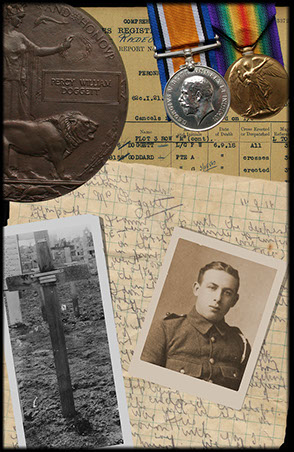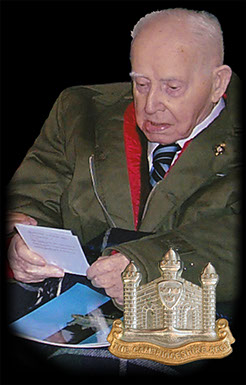
The Cambs
at War
Who Were
The Cambs
1/1st Btn 1914-1919
1914 - 1/1st Overview
1915 - 1/1st Overview
1915 - St Eloi
1915 - Fosse Wood
1916 - 1/1st Overview
1916 - The Schwaben
1916 - St Pierre Divion
1917 - 1/1st Overview
1917 - St Julien
Insignia, Medals & Books
Remembering The Cambs
Biographies
About Us &
This Site

Medals, letters and pictures of Percy Doggett.
Many of the Cambridgeshires killed on the Western Front have no known grave - for a more detailed look at the Regiment's missing please click here

George White in October 1999.
The Cost of Victory
The Cambridgeshire Regiment arrived in France on the 15th February 1915; they suffered their first man killed by enemy fire less than three weeks later. It happened on the 4th March 1915 when Cpl Noble Dewey was shot and killed by a sniper while trench digging behind the front line. While he was the first man killed by the enemy he was not the Cambs first casualty of the war. Three days after being mobilised and when the Battalion reached Romford Cpl Arthur Rawson from Whittlesey was shot in the leg in a tragic accident. Despite all attempts to save him the severity of the wound and shock led to his death in the early hours of the next morning on 9th August 1914.
The last man killed in action during the war was Pte Clement Strange who was killed on the 22nd October 1918. Pte Clement Strange was from Cambridge and enlisted in the first weeks of the war. He had spent years in France and Flanders having first gone out with the Battalion in February 1915. He was by no means the last man the Cambs lost though as others died of wounds, sickness or in accidents. The last Cambs man to die during the war was also their first official casualty. 2nd Lt Gilbert McMicking had the misfortune of being in Germany studying at the outbreak of the war and despite several attempts to escape spent the duration of the war as a Prisoner of War. He died of influenza in a Dutch internment camp on the 11th November 1918, the day the Armistice was signed. Many of those who fell during the War have no known grave and are listed on the various large memorials to the missing, for more information please click here.
Men continued to die from wounds and sickness connected to their active service for months and even years after the cessation of hostilities (see Sickness and the Soldier page for more info). This is one of several factors that make it difficult to give an exact total figure for those lost. The regimental history The Cambridgeshires 1914 to 1919 written by Riddell and Clayton gives the total number killed in action, died of wounds, disease, or accidents while serving in the Cambs as 866 (77 officers and 789 other ranks). However there is no date range mentioned for this total. Similarly the Soldiers Died in the Great War lists 844 (64 officers and 780 other ranks) however this does not take into account many of the officers attached with the Cambs from other regiments when they were killed.
The Riddell and Clayton book also provides the best estimate for the number of men wounded while serving in the Cambs, it gives a total of 159 officers and 3299 other ranks wounded. It is worth noting though that many of these are likely to be men that were wounded on multiple occasions and were counted again each time they were wounded. The number of men who became Prisoner of War is also given as 175.
All of these collated figures only count men who were killed, wounded or taken PoW while serving in the Cambs and do not take into account the casualty figures for the huge number of men who although originally enlisted in the Cambs found themselves in different regiments once drafted to France. Unfortunately there is not any means to accurately calculate this figure.
For many of the Cambs men the physical and mental cost of the war would remain with them for the rest of their lives. At least 700 Cambs men were discharged and issued a "Silver War Badge" to show they were no longer able to serve on medical grounds. Many of these were injured men discharged after being found to be "no longer physically fit for war service" or suffering from severe mental and nervous problems connected to shell shock. Sickness and disease was another legacy that left its mark on many of the returning Cambs men. Trench fever, bronchitis, nephritis, and many other conditions connected to the war left many men weakened and had an effect on the rest of their lives.
In the early 1920s as the nation's population tried to heal and come to terms with the losses, war memorials were built in nearly every town and village. The unveiling of new local memorials gave many ex Cambs men the chance to meet up with old comrades again and attendance was always high. Throughout the county branches of the Cambridgeshire Regiment Old Comrades Association were formed and alongside the branches of the British Legion gave the men a place to go and be with those who knew the horrors that only those who were there could understand.
More than 10,000 men served in the Cambs at some point between 1908 and 1920, many making the ultimate sacrifice on the fields of France and Flanders. The last known WW1 Cambridgeshire Regiment veteran, George Edward White, died in 2001.
While the men of the Cambs TF may all be gone their lives, sacrifices, and deeds have not and will not be forgotten.

This site went live on the 14th February 2015 to mark 100 years since the 1/1st Cambs went off to war.
WE WILL REMEMBER THEM
Email us: cambsregt@gmail.com
Copyright 2015, 2016, 2017, 2018, 2019 by Felix Jackson. The information and images on this site should not be reproduced without prior permission.